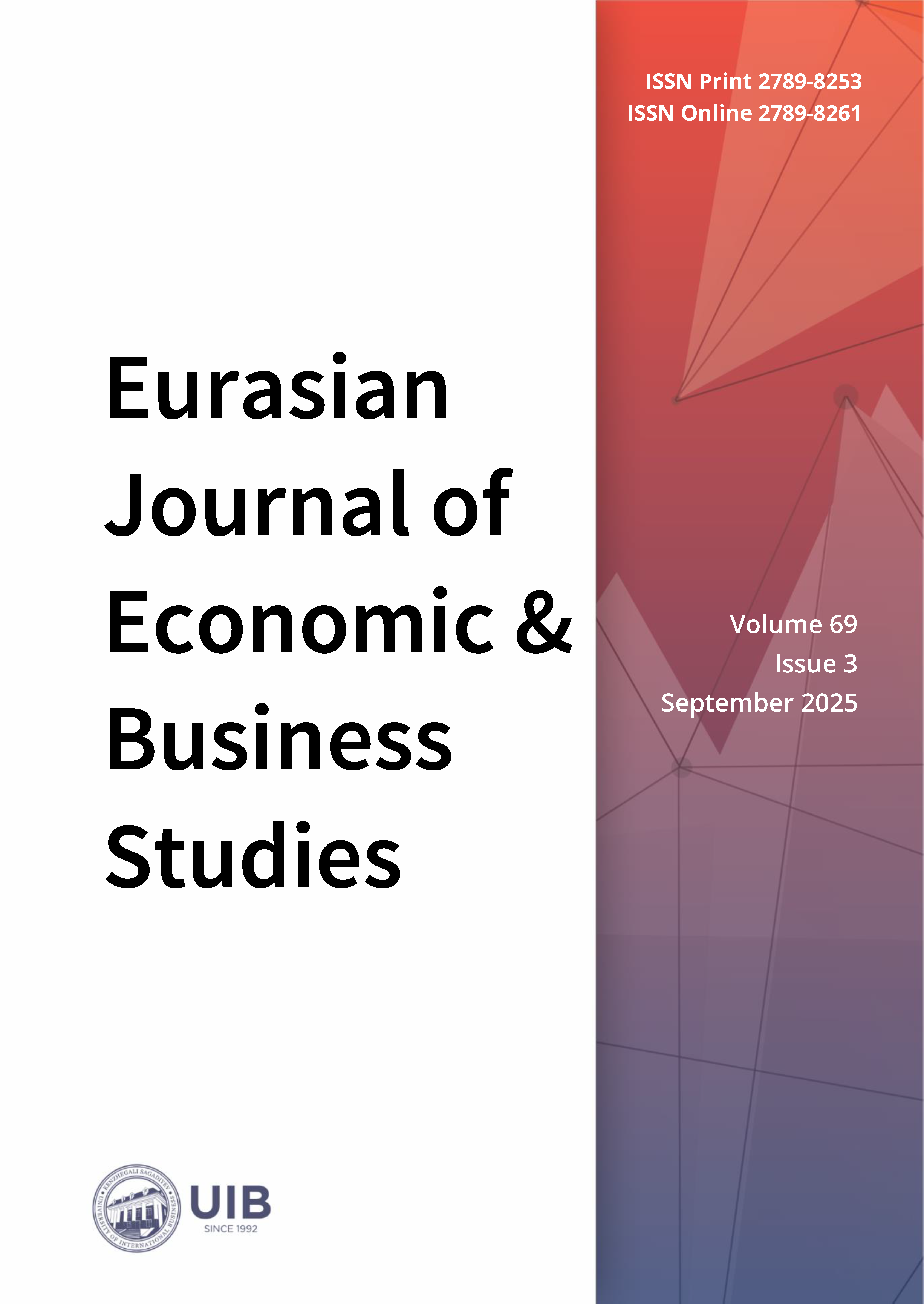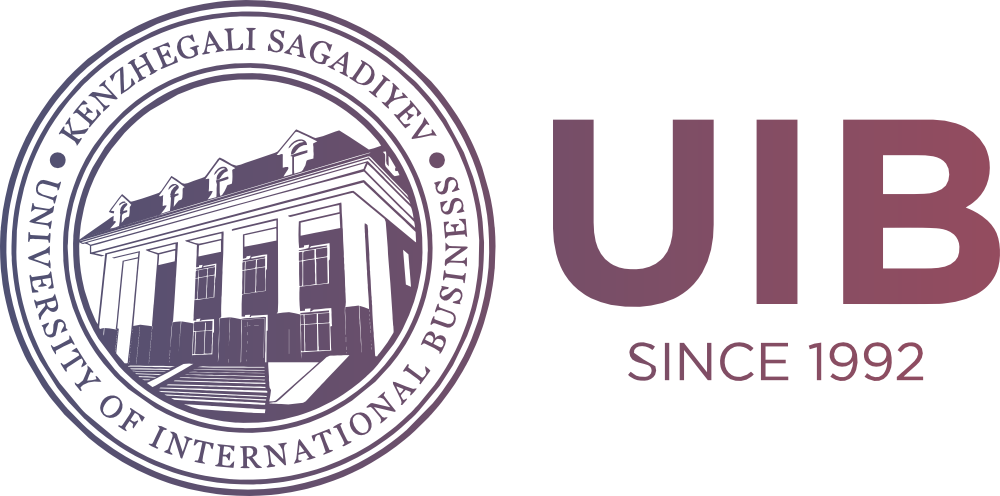Assessment of SME Loan Portfolio Quality in Kazakhstan: Empirical Analysis from 2013 to 2023
DOI:
https://doi.org/10.47703/ejebs.v69i3.549Keywords:
Economy, Economic Growth, Small Business, Medium-Sized Businesses, Business Lending, Overdue Debt, Financial Stability, Loan PortfolioAbstract
The article is devoted to the assessment of the quality of the loan portfolio of small and medium-sized businesses (SMEs) in Kazakhstan to identify periods of credit instability and hidden risks that can limit the investment potential of enterprises. The methodological framework encompasses an analysis of the overdue debt structure, calculation of the sustainability coefficient and delinquency index, as well as cluster analysis to identify periods with varying degrees of credit risk. The results showed that the share of loans without delay increased from 69.2% in 2013 to 94.2% in 2023, while the share of problem loans over 90 days decreased from 23.9% to 3.9%. The overdue debt index decreased from 0.31 to 0.06, and the sustainability coefficient exceeded 5.5 in 2022, indicating an improvement in payment discipline and the ability of SMEs to service debts. The cluster analysis identified two periods: the crisis (2017-2018) and the recovery (2021-2023), which confirms the need for a differentiated policy in managing credit risks. The study confirmed the presence of cyclicity in the dynamics of SME credit risks and showed that the stabilization of the loan portfolio is possible only with a combination of macroprudential tools, government support programs and digitalization of credit monitoring. Future studies could focus on ESG factors and the level of digitalization of enterprises in credit risk assessment models, as well as comparative cross-country studies to identify adaptive policies in the context of regional differences.
Downloads
References
Abakirov, M.A., Abakirov, S., Avazov, E., Baialieva, E., Kazieva, M., Kurmankojoeva, R., & Mamytova, E. (2019). Special aspects of IFRS 9 application by credit guarantee funds in developing countries. Reforma, 2(82), 46-60.
Abbasi, W. A., Wang, Z., & Abbasi, D. A. (2017). Potential sources of financing for small and medium enterprises (SMEs) and role of government in supporting SMEs. Journal of Small Business and Entrepreneurship Development, 5(2), 39-47. https://doi.org/10.15640/jsbed.v5n2a4
Beck, T. (2013). Bank financing for SMEs–lessons from the literature. National institute economic review, 225(1), R23-R38. https://doi.org/10.1177/002795011322500105
Beenstock, M. (2025). Evaluating Subsidized Credit Policy in Kazakhstan with SME and Spatial Panel Data: First-and Second-Best Policy. Comparative Economic Studies, 1-29. https://doi.org/10.1057/s41294-025-00257-1
Berger, A. N., & Udell, G. F. (2006). A more complete conceptual framework for SME finance. Journal of Banking & Finance, 30(11), 2945-2966. https://doi.org/10.1016/j.jbankfin.2006.05.008
Breuer, T., Jandačka, M., Mencía, J., & Summer, M. (2012). A systematic approach to multi-period stress testing of portfolio credit risk. Journal of Banking & Finance, 36(2), 332-340. https://doi.org/10.1016/j.jbankfin.2011.07.009
Buncic, D., & Melecky, M. (2013). Macroprudential stress testing of credit risk: a practical approach for policy makers. Journal of Financial Stability, 9(3), 347-370. https://doi.org/10.1016/j.jfs.2012.11.003
Calabrese, R., Girardone, C., & Sclip, A. (2020). Financial fragmentation and SMEs’ access to finance. Small Business Economics, 57(4), 2041-2065. https://doi.org/10.1007/s11187-020-00393-1
Chowdhury, M., & Alam, Z. (2017). Factors affecting access to finance of small and medium enterprises (SMEs) of Bangladesh. USV Annals of Economics and Public Administration, 2(26), 55.
Department for Business and Trade. (2023). SME Digital Adoption Taskforce: Summary of interim report. Retrieved July 30, 2025 from https://www.gov.uk/government/publications/sme-digital-adoption-taskforce-interim-report/sme-digital-adoption-taskforce-summary-of-interim-report
Dietsch, M., & Petey, J. (2002). The credit risk in SME loans portfolios: Modeling issues, pricing, and capital requirements. Journal of Banking & Finance, 26(2-3), 303-322. https://doi.org/10.1016/S0378-4266(01)00224-2
Duarte, F. D., Gama, A. P. M., & Gulamhussen, M. A. (2018). Defaults in bank loans to SMEs during the financial crisis. Small Business Economics, 51(3), 591-608. https://doi.org/10.1007/s11187-017-9944-9
Em, O., Georgiev, G., Radukanov, S., & Petrova, M. (2022). Assessing the market risk on the government debt of kazakhstan and bulgaria in conditions of turbulence. Risks, 10(5), 93. https://doi.org/10.3390/risks10050093
Höck, A., Klein, C., Landau, A., & Zwergel, B. (2020). The effect of environmental sustainability on credit risk. Journal of Asset Management, 21(2), 85-93. https://doi.org/10.1057/s41260-020-00155-4
Hossain, M., Yoshino, N., & Tsubota, K. (2023). Sustainable financing strategies for the SMEs: Two alternative models. Sustainability, 15(11), 8488. https://doi.org/10.3390/su15118488
IMDA. (2023). SMEs Go Digital. Government of Singapore. Retrieved July 30, 2025 from https://www.imda.gov.sg/how-we-can-help/smes-go-digital
Karybay, S., & Zhussupov, A. (2024). The Effects of Regulatory Restrictions on the Financial and Credit System of Kazakhstan. WSEAS Transactions on Business and Economics, 21, 2769-2780. https://doi.org/10.37394/23207.2024.21.226
Kumar, D., Phani, B. V., Chilamkurti, N., Saurabh, S., & Ratten, V. (2023). Filling the SME credit gap: a systematic review of blockchain-based SME finance literature. Journal of trade science, 11(2/3), 45-72. https://doi.org/10.1108/JTS-06-2023-0003
Lambekova, A. N., Temirbekova, L. A., & Syzdykova, E. Z. (2020). Internal audit of banks: methodological model for reducing credit risk (Logit model). Buketov Business Review, 97(1), 66-74. https://doi.org/10.31489/2020ec1/66-74
Novotny-Farkas, Z. (2016). The interaction of the IFRS 9 expected loss approach with supervisory rules and implications for financial stability. Accounting in Europe, 13(2), 197-227. https://doi.org/10.1080/17449480.2016.1210180
Nizaeva, M., & Coskun, A. (2021). Determinants of the financial constraint and its effects on the SME growth in Central Asia. Eurasian Journal of Business and Economics, 14(27), 1-28. https://doi.org/10.17015/ejbe.2021.027.01
Nurpeissova, M., Saimagambetova, G., Omarova, A., Saubetova, B., & Baishukurova, Z. (2025). Kazakhstan's Banking Sector: Between Domestic Regulation and Macroeconomic Trends. Eurasian Journal of Economic and Business Studies, 69(1), 64-80. https://doi.org/10.47703/ejebs.v69i1.464
OECD. (2023). Digitalisation of SMEs. Organisation for Economic Co-operation and Development. Retrieved July 30, 2025 from https://www.oecd.org/en/topics/digitalisation-of-smes.html
Osano, H. M., & Languitone, H. (2016). Factors influencing access to finance by SMEs in Mozambique: case of SMEs in Maputo central business district. Journal of innovation and entrepreneurship, 5(1), 13. https://doi.org/10.1186/s13731-016-0041-0
Resende, M., Carvalho, C., & Carmo, C. (2024). Impacts of the expected credit loss model on pro-cyclicality, earnings management, and equity management in the Portuguese banking sector. Journal of Risk and Financial Management, 17(3), 112. https://doi.org/10.3390/jrfm17030112
Shim, J. (2019). Loan portfolio diversification, market structure and bank stability. Journal of Banking & Finance, 104, 103-115. https://doi.org/10.1016/j.jbankfin.2019.04.006
Schutte, W. D., Verster, T., Doody, D., Raubenheimer, H., & Coetzee, P. J. (2020). A proposed benchmark model using a modularised approach to calculate IFRS 9 expected credit loss. Cogent Economics & Finance, 8(1), 1735681. https://doi.org/10.1080/23322039.2020.1735681
Weber, O., Scholz, R. W., & Michalik, G. (2010). Incorporating sustainability criteria into credit risk management. Business strategy and the environment, 19(1), 39-50. https://doi.org/10.1002/bse.636
Zaitenova, N., & Abzhalelova, S. (2025). Assessment of Bank Profitability through Structural Indicators: Evidence from Kazakhstan. Eurasian Journal of Economic and Business Studies, 69(2), 79-94. https://doi.org/10.47703/ejebs.v69i2.514
How to Cite
Downloads
Published
Issue
Section
License

This work is licensed under a Creative Commons Attribution 4.0 International License.
Authors retain copyright and grant the journal right of first publication with the work simultaneously licensed under a Creative Commons Attribution (CC-BY) 4.0 License that allows others to share the work with an acknowledgment of the work’s authorship and initial publication in this journal.



